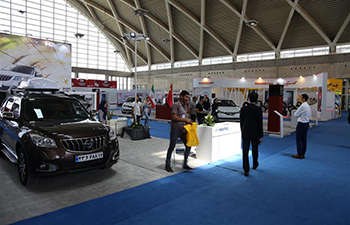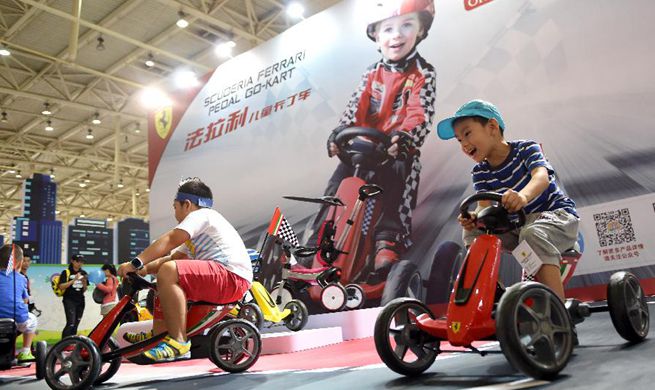FUZHOU, July 12 (Xinhua) -- Although it is the height of summer, Chinese company Qipai Group is eager to show off its new jackets. A USB cable is unfurled from an inside pocket and plugged into a power bank, and in half a minute, the high-tech jacket warms to 55 degrees Celsius.
It is the latest version of a heat-generating jacket developed by Fujian Qipai Group, a garment maker in Jinjiang, a manufacturing hub for clothing and footwear in east China's Fujian Province.
"We use graphene to generate heat because it produces heat efficiently with low risk of electricity leakage," said Huang Xiaogong, while pulling out a paper-like black sheet from the jacket.
According to Huang, the company chairman's IT assistant, Qipai entered the smart clothing market in 2016 by integrating devices into clothes, such as jackets equipped with wristbands in the cuffs to monitor activity and health and boards fitted with copper cables to generate heat.
The company has replaced copper with graphene as the heat-generating material in its new smart jackets, expected to debut this winter.
In recent years, local garment manufacturers have been trying to combine fashion with tech amid fierce competition and overcapacity in the sector, some pinning their hopes on graphene, a new material.
The local government established a graphene institute hoping it would revolutionize its traditional industries. The institute, established in 2015, focuses on both basic research and development of graphene-related products.
Xu Zhi, chief scientist of Fujian Research Institute of Industrial Graphene Technologies, illustrated the magical powers of the material by hurling an egg at a graphene-filled shoe sole. The egg bounced high into the air, but did not break until it eventually hit the ground.
Adding graphene to the soles of shoes makes them more elastic, deodorizing, and lightweight, Xu said.
The institute has managed to apply the uncommon properties of graphene to footwear, batteries and air purification.
According to Xu, the institute has a 160-million-yuan (24.2 million U.S. dollars) contract with a local garment company called Guirenniao to produce insoles that are light, self-sterilizing and comfortable.
With over 3,000 footwear companies, Jinjiang is the "world's factory" for sportswear, producing 40 percent of the country's athletic shoes and 20 percent of the world's.
Xu, who obtained his doctoral degree at Stanford University, is among the highly skilled workers who have been attracted to Jinjiang as part of the local government's plans to upgrade the economy through high-tech manufacturing industries.
In order to attract Chinese and foreign professionals, the city decided to allocate 100 million yuan to support start-ups every year. A start-up team may be granted up to 30 million yuan, and individuals are eligible for subsidies of up to 8 million yuan, plus a home purchase subsidy capped at 800,000 yuan.
"In addition to preferential policies, I decided to settle here because it offers a brand new platform where I can make a change in local companies," said Han Jun, who quit his job at Switzerland's Paul Scherrer Institute and joined Quanzhou Institute of Equipment Manufacturing at the Chinese Academy of Sciences in 2014.
The institute has 12 young scientists like Han who came to Jinjiang from abroad. After almost starting from scratch, they are already making breakthroughs.
Han, whose research is related to spectral imaging methods, has come up with a solution to a local company's problem.
For Heng'an Group, a local sanitary napkin and baby diaper manufacturer, uneven distribution of the liquid-absorbing polymers used in products has been a problem, as the distribution is hard to measure through traditional methods.
By using Han's spectral imaging method, uneven distribution of the polymer can be detected online and the production technique can be adjusted in real time to ensure product quality.
So far, seven national research organizations have set up branches in Jinjiang, and 2,375 skilled workers have been recruited to the city.
In 2017, Jinjiang's gross domestic product (GDP) amounted to 198.15 billion yuan with a growth rate of 8.2 percent, higher than the national rate, and 2.65 percent of its GDP was invested in research and development.
As China's economy shifts from high-speed growth to high-quality development, Jinjiang is working to optimize its industrial structure by promoting emerging high-tech industries while advancing its traditional manufacturing clusters.
Fujian Jinhua Integrated Circuit Co., Ltd., an advanced integrated circuit (IC) manufacturing company founded in 2016, is a shining example of the city's efforts to sharpen its competitive edge.
Co-invested by the provincial government and Jinjiang city government, the company will focus on the development of high-end memory technology and the manufacturing of related products.
The plant is under construction and is expected to go into production in September this year.
According to Wang Wenhui, vice mayor of Jinjiang, the city has vowed to attract upstream and downstream enterprises in the sector to build a complete industrial chain.
"Jinjang is expected to grow into an important base of IC design and manufacturing in the world by 2025 with an annual output of over 100 billion yuan," he said.

















